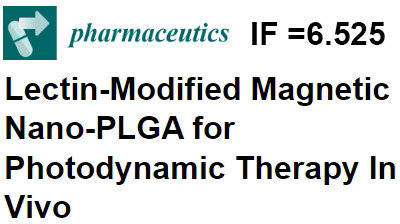Press-room / news / Science news /
Lectin-Modified Magnetic Nano-PLGA for Photodynamic Therapy In Vivo
The extreme aggressiveness and lethality of many cancer types appeal to the problem of the development of new-generation treatment strategies based on smart materials. The targeted delivery of nanoparticles to specific cancer cell receptors is believed to be such a strategy; however, there are no targeted nano-drugs that have successfully completed clinical trials to date. To meet the challenge, the team of the Laboratory of Molecular Immunology of the Shemyakin-Ovchinnikov Institute of Bioorganic Chemistry of the Russian Academy of Sciences, the Laboratory for Biochemical Research of Carcinogenesis of the Moscow Institute of Physics and Technology, and the Department of Nanobiomedicine of the Sirius University, have developed an alternative method of oncotherapy.
Researchers developed for the first time the method of the targeting of lectin-equipped polymer nanoparticles to the glycosylation profile of cancer cells, followed by photodynamic therapy (PDT). PDT is one of the most promising cancer treatment strategies, being based on the absorption of light by a photosensitizer and the conversion of oxygen into reactive oxygen species (ROS). We synthesized polymer nanoparticles loaded with magnetite and a PDT agent, IR775 dye (mPLGA/IR775). The magnetite incorporation into the PLGA particle structure allows for the quantitative tracking of their accumulation in different organs and the performing of magnetic-assisted delivery, while IR775 makes fluorescent in vivo bioimaging as well as light-induced PDT possible. To equip PLGA nanoparticles with targeting modality, the particles were conjugated with ConA lectin, lectin purified from jack bean (Canavalia ensiformis) that specifically binds D-mannose/D- glucose residues on the cell surface.
In vivo experiments showed diagnostic and therapeutic capabilities of mPLGA/IR775–ConA nanoparticles after i.v. administration in mice. mPLGA/IR775–ConA nanoparticles efficiently accumulated in the allograft tumors, the application of a magnetic field increased the delivery of nanoparticles into the tumor by 1.6 times. mPLGA/IR775–ConA nanoparticles produced a bright fluorescent signal for in vivo bioimaging using the fluorescent properties of IR775 dye inside the nanoparticles. BALB/c mice with large solid tumors of more than 200 mm 3 were treated with mPLGA/IR775-ConA nanoparticles followed by light irradiation (808 nm laser). Single session of PDT led to 100% tumor growth inhibition. The obtained results indicate that the mPLGA/IR775 nanostructure has great potential to become a highly effective diagnostic and therapeutic agent.
Lectin-modified nano-PLGA nanoparticles loaded with photodynamic therapy sensitizer (IR775) and magnetite (mPLGA/IR775) were shown to be effective theranostic agents, realizing effective magnetically assisted targeted delivery, tumor bioimaging, and treatment under external light irradiation. The in vitro and in vivo functionality of these nanoparticles were thoroughly tested, and 100% inhibition of allograft solid tumor growth was shown, thus confirming the great potential of the developed nanoformulation for bioimaging and photodynamic therapy.
The results are published in Pharmaceutics.

february 1, 2023


